Egg cell
| Egg cell | |
|---|---|
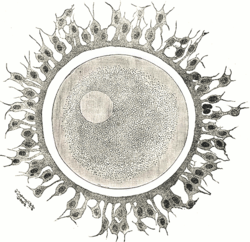 A human egg cell with surroundingcorona radiata | |
| Details | |
| Identifiers | |
| Latin | ovum |
| Greek | ωάριο (oário) |
| MeSH | D010063 |
| FMA | 67343 |
| Anatomical terms of microanatomy | |
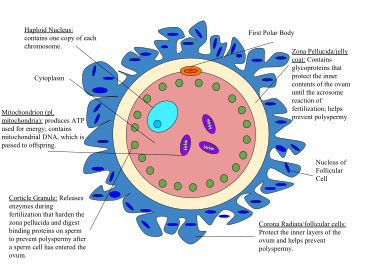
Theegg cellorovum(pl.:ova) is thefemalereproductivecell, orgamete,[1]in mostanisogamousorganisms (organisms thatreproduce sexuallywith a larger, female gamete and a smaller, male one). The term is used when the female gamete is not capable of movement (non-motile). If the male gamete (sperm) is capable of movement, the type of sexual reproduction is also classified asoogamous.A nonmotile female gamete formed in the oogonium of some algae, fungi, oomycetes, or bryophytes is anoosphere.[2]When fertilized, the oosphere becomes theoospore.[clarification needed]
When egg and sperm fuse duringfertilisation,adiploidcell (thezygote) is formed, which rapidly grows into a new organism.
History
[edit]While the non-mammalian animal egg was obvious, the doctrineex ovo omne vivum( "every living [animal comes from] an egg" ), associated withWilliam Harvey(1578–1657), was a rejection ofspontaneous generationandpreformationismas well as a bold assumption that mammals also reproduced via eggs.Karl Ernst von Baerdiscovered the mammalian ovum in 1827.[3][4]The fusion of spermatozoa with ova (of a starfish) was observed byOskar Hertwigin 1876.[5][6]
Animals
[edit]In animals, egg cells are also known asova(singularovum,from theLatinwordovummeaning 'egg').[7]The termovulein animals is used for the young ovum of an animal. In vertebrates, ova are produced by femalegonads(sex glands) calledovaries.A number of ova are present at birth inmammalsand mature viaoogenesis.
Studies performed on humans, dogs, and cats in the 1870s suggested that the production ofoocytes(immature egg cells) stops at or shortly after birth. A review of reports from 1900 to 1950 by zoologistSolomon Zuckermancemented the belief that females have a finite number of oocytes that are formed before they are born. This dogma has been challenged by a number of studies since 2004. Several studies suggest thatovarian stem cellsexist within the mammalian ovary. Whether or not mature mammals can actually create new egg cells remains uncertain and is an ongoing research question.[8][9]
Mammals including humans
[edit]
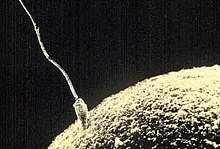
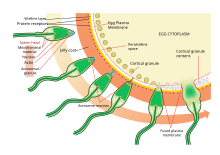
In allmammals,the ovum is fertilized inside the female body. Human ova grow from primitive germ cells that are embedded in the substance of theovaries.[10]
The ovum is one of the largestcellsin the human body, typically visible to the naked eye without the aid of amicroscopeor other magnification device.[11]The human ovum measures approximately 120 μm (0.0047 in) in diameter.[12]
Ooplasm
[edit]Ooplasm is like the yolk of the ovum, a cell substance at its center, which contains itsnucleus,named thegerminal vesicle,and thenucleolus,called thegerminal disc.[13]
The ooplasm consists of thecytoplasmof the ordinary animal cell with itsspongioplasmandhyaloplasm,often called theformative yolk;and thenutritive yolkordeutoplasm,made of rounded granules of fatty andalbuminoidsubstances imbedded in the cytoplasm.[13]
Mammalianova contain only a tiny amount of the nutritive yolk, for nourishing theembryoin the early stages of its development only. In contrast, bird eggs contain enough to supply the chick with nutriment throughout the whole period of incubation.[13]
Ova development in oviparous animals
[edit]In theoviparousanimals (allbirds,mostfish,amphibiansandreptiles), the ova develop protective layers and pass through theoviductto the outside of the body. They are fertilized by male sperm either inside the female body (as in birds), or outside (as in many fish). After fertilization, an embryo develops, nourished by nutrients contained in the egg. It then hatches from the egg, outside the mother's body. Seeeggfor a discussion of eggs of oviparous animals.
The egg cell'scytoplasmandmitochondriaare the sole means the egg can reproduce by mitosis and eventually form ablastocystafter fertilization.
Ovoviviparity
[edit]There is an intermediate form, theovoviviparousanimals: the embryo develops within and is nourished by an egg as in the oviparous case, but then it hatches inside the mother's body shortly before birth, or just after the egg leaves the mother's body. Some fish, reptiles and manyinvertebratesuse this technique.
Plants
[edit]Nearly all land plants have alternatingdiploidandhaploidgenerations. Gametes are produced by the haploid generation, which is known as thegametophyte.The female gametophyte produces structures calledarchegonia,and the egg cells form within them viamitosis.The typicalbryophytearchegonium consists of a long neck with a wider base containing the egg cell. Upon maturation, the neck opens to allow sperm cells to swim into the archegonium and fertilize the egg. The resulting zygote then gives rise to an embryo, which will grow into a new diploid individual, known as asporophyte.Inseed plants,a structure called theovulecontains the female gametophyte. The gametophyte produces an egg cell. Afterfertilization,the ovule develops into aseedcontaining the embryo.[14]
Inflowering plants,the female gametophyte (sometimes referred to as the embryo sac) has been reduced to just eight cells inside theovule.The gametophyte cell closest to themicropyleopening of the ovule develops into the egg cell. Uponpollination,a pollen tube delivers sperm into the gametophyte and one sperm nucleus fuses with the egg nucleus. The resulting zygote develops into an embryo inside the ovule. The ovule, in turn, develops into aseedand in many cases, theplant ovarydevelops into afruitto facilitate thedispersalof the seeds. Upongermination,the embryo grows into aseedling.[14]
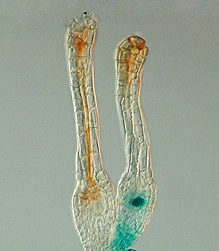
In themossPhyscomitrella patens,thePolycombprotein FIE is expressed in the unfertilised egg cell (Figure, right) as the blue colour afterGUS stainingreveals. Soon after fertilisation the FIE gene is inactivated (the blue colour is no longer visible, left) in the young embryo.[15]
Other organisms
[edit]Inalgae,the egg cell is often called oosphere.[citation needed]Drosophilaoocytes develop in individual egg chambers that are supported by nurse cells and surrounded by somatic follicle cells. The nurse cells are large polyploid cells that synthesize and transfer RNA, proteins, and organelles to the oocytes. This transfer is followed by the programmed cell death (apoptosis) of the nurse cells. During oogenesis, 15 nurse cells die for every oocyte that is produced.[16]In addition to this developmentally regulated cell death, egg cells may also undergo apoptosis in response to starvation and other insults.[16]
See also
[edit]References
[edit]- ^"Ovum".Biology Dictionary.BiologyOnline. 7 October 2019.Retrieved21 January2023.
- ^"Oosphere Meaning".YourDictionary.Retrieved12 April2021.
- ^Cobb, M. (August 2012)."An amazing 10 years: the discovery of egg and sperm in the 17th century".Reprod Domest Anim.47(Suppl 4): 2–6.doi:10.1111/j.1439-0531.2012.02105.x.PMID22827343.
- ^""Conclusio" from Carl Ernst von Baer's De Ovi Mammalium et... "(jpeg).
- ^Needham, Joseph(1959).A History of Embryology(2nd, revised ed.). Cambridge, England, UK: Cambridge University Press.
- ^Lopata, Alex (April 2009). "History of the Egg in Embryology".Journal of Mammalian Ova Research.26(1): 2–9.doi:10.1274/jmor.26.2.S2CID86828337.
- ^Lewis, Charlton T.; Short, Charles (1879)."ōvum".A Latin Dictionary.Perseus Digital Library.
- ^Horan CJ, Williams SA (July 2017)."Oocyte stem cells: fact or fantasy?".Reproduction.154(1): R23–R35.doi:10.1530/REP-17-0008.PMID28389520.S2CID207156647.
- ^Telfer EE, Anderson RA (February 2019)."The existence and potential of germline stem cells in the adult mammalian ovary".Climacteric.22(1): 22–26.doi:10.1080/13697137.2018.1543264.PMC6364305.PMID30601039.
- ^Regan, Carmen L. (2001)."Pregnancy".In Worell, Judith (ed.).Encyclopedia of Women and Gender: Sex Similarities and Differences and the Impact of Society on Gender.Vol. 1. Academic Press. p. 859.ISBN9780122272455.Retrieved3 November2013.
- ^Alexander, Rachel; Davies, Mary-Ann; Major, Vicky; Singaram, S. Veena; Dale-Jones, Barbara (2006).X-kit Anatomy.Pearson South Africa. p. 3.ISBN978-1-86891-380-0.
- ^Alberts, Bruce; Johnson, Alexander; Lewis, Julian; Raff, Martin; Roberts, Keith; Walter, Peter (2002)."Eggs".Molecular Biology of the Cell(4th ed.). New York, US: Garland Science.ISBN0-8153-3218-1.
- ^abc"The Ovum".Gray's Anatomy.Retrieved18 October2010.
- ^abEsau, K. (1977).Anatomy of seed plants(second ed.). New York: John Wiley and Sons.ISBN978-0-471-24520-9.
- ^Mosquna, Assaf; Katz, Aviva; Decker, Eva L.; Rensing, Stefan A.;Reski, Ralf;Ohad, Nir (2009)."Regulation of stem cell maintenance by the Polycomb protein FIE has been conserved during land plant evolution".Development.136(14): 2433–2444.doi:10.1242/dev.035048.PMID19542356.
- ^abMcCall K (October 2004). "Eggs over easy: cell death in theDrosophilaovary ".Dev. Biol.274(1): 3–14.doi:10.1016/j.ydbio.2004.07.017.PMID15355784.
External links
[edit]- The Ovarian Kaleidoscope Databasedescription of 1800 genes involved in ovarian functions
